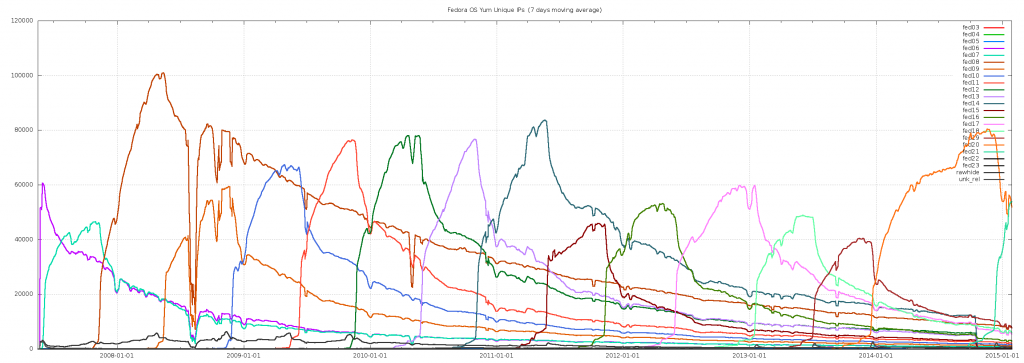Fedora is a big project, and it’s hard to keep up with everything that goes on. This series highlights interesting happenings in five different areas every week. It isn’t comprehensive news coverage — just quick summaries with links to each. Here are the five things for February 3rd, 2015:
Vote now in FESCo Elections
The election for Fedora 22 – Fedora 23 members of FESCo (the Fedora Engineering Steering Committee) is now open (through 00:00 February 4th — note that that’s today, Tuesday, February 3rd — and early evening in the United States). Read interviews with candidates here:
- Debarshi Ray (rishi)
- Parag Nemade (paragan)
- Tomas Hozza (thozza)
- David King (amigadave)
- Kevin Fenzi (nirik)
Adam Jackson (ajax) and Alberto Ruiz (aruiz) are also running but no interviews area available. See the Elections wiki for each candidates’ self-nomination. Read the interviews, and then vote!
(Note that the Environments and Stacks Working Group had a number candidates equal to the number of open slots, and so decided no election is necessary for that group.)
Get Swag from the Fedora Store!
Thanks to Ruth Suehle, we now have an official store for Fedora-branded swag. As Ruth explains, we’re leveraging Red Hat’s “Cool Stuff Store” for this, because it helps us with legal obligations as well as inventory and financial requirements. This is a sort of trial run, with four items to start. If it’s successful, we can have more (and possibly look at expanding to other countries — we are very aware that the current international shipping prices are… not great).
(I see that many shirt sizes are already out of stock, so that’s a good sign!)
Also note: these items are priced at our cost; Red Hat and Fedora aren’t making any money this way (we really can’t, even if we wanted to). It’s just an easy way for you to get Fedora-branded gear.
Fedora Job Opening: Infrastructure Engineer
The Fedora Infrastructure team headed by Paul Frields has a new opening! See the Red Hat Jobs page for full details, but the quick summary is that we’re looking for a software engineer / programmer with experience in continuous delivery to help the Release Engineering team build the next generation of the tools we use to produce Fedora.
The job listing came out highly slanted towards Project Atomic, as that is the current hotness, but don’t expect to be pigeonholed there. Do you have experience as a site reliability engineer? Is your instinct to develop systems to pass arbitrary condiments? Have you been doing actual devops for so long that you just sigh about how the term is used today? Does Fedora’s six-month release cycle seem disturbingly slow — and you know what to do about it? This may be the job for you!
(Note that the job is listed as in Raleigh, North Carolina, but we are open to applicants worldwide.)
Fedora Yum Connection Stats
More on this later, but here’s a chart Stephen Smoogen put together for my presentations at FOSDEM and DevConf.cz:
The data counts updates-mirror connections from the same IP address a single time a day. Smooge notes that a large number of caveats should be considered, including changing use of NAT over time and increasingly short DHCP leases. Also, this almost exclusively counts North America and Europe, where cheap always-on Internet is commonplace. And, of course, it only counts systems which actually check for updates regularly; many don’t.
So, with all of those caveats aside, there are some interesting points.
There’s a general third/third/third split in updating: when new Fedora release comes out, a third of users update almost immediately, another third update by end-of-life when the “N+1” release is out, and the final third are end up as a long tail which persists forever.
The chart basically starts with Fedora 6, and as you can see, Fedora 8 was very, very popular. If you take F8 out, you see a general period of growth in the peaks from F6 onward, until we hit Fedora 15 (a release with a lot of change, including systemd and Gnome 3). Those users didn’t leave, though — they just didn’t update, and F15 never exceeded F14 during its supported lifetime.
Now, it’s heartening to see Fedora 20 back up to the levels of earlier releases — and I note that F21 just crossed up over F20 in use, so we’re off to a great start here, too.
Fedora, EPEL, and CentOS
At the FOSDEM conference in Brussels, we had a very productive meetup between CentOS project contributors and EPEL and Fedora members, about increased collaboration — making EPEL more official in CentOS, and making it easier for CentOS contributors to join in maintaining packages in EPEL. We also talked about the need for multiple versions of software, and Software Collections (SCLs) as one possible solution (as Tom Callaway noted, Fedora guidelines for these are approved by the Fedora Packaging Committee, so it’s no problem to use them in EPEL). I didn’t take notes, but others did, and there should be more on this soon on the epel-devel mailing list.








Justin W. Flory
I was so excited to get my hands on a t-shirt! Can’t wait to start wearing it around. 🙂
Michael T. Babcock
Its pretty sad that I see the FESco elections information the day after it closes because the story was posted on the final day of voting. Sigh.
Ryan Lerch
Sad that you missed the vote 🙁
We did also post the interviews with all the candidates last week here on the magazine, and those posts stated the election closing dates.
The Fedora Announce list is also the best way to keep track of upcoming votes and other important Fedora Community messages. It is pretty low traffic (5-10 messages a month).
Matthew Miller
Sorry about that! We also had articles last week covering the candidates. You also may want to subscribe to the Fedora Announce List — it’s low traffic, with only a few messages a month, but covers things like this.
Karsten Wade
Regarding the EPEL meeting at FOSDEM, I took notes, confirmed a few details with Karanbir Singh and Mike McLean, and posted them to the event page on the CentOS wiki:
http://wiki.centos.org/Events/Fosdem2015 > Notes from meeting (INCOMPLETE)
They are marked incomplete until others get a chance to read them over and add/fix/adjust to match our best consensus of what was said. I do think I got most of the major points, but especially important may be any items we agreed upon or resolved perceived issues.